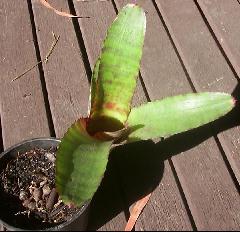


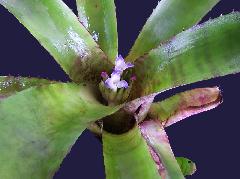
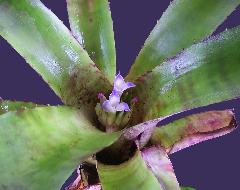



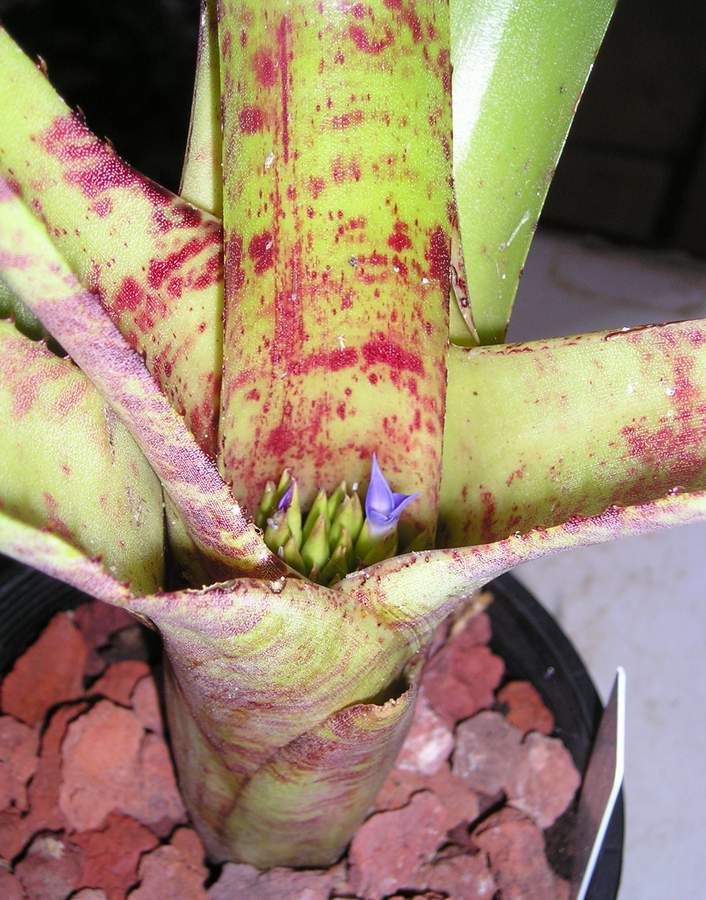
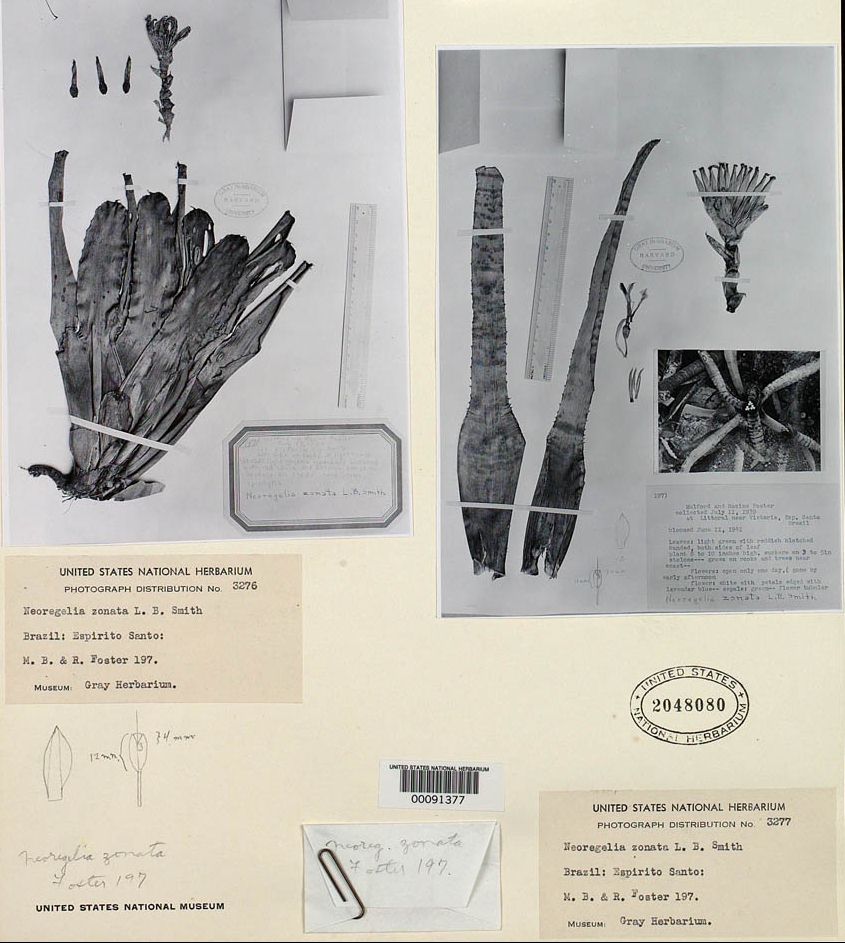
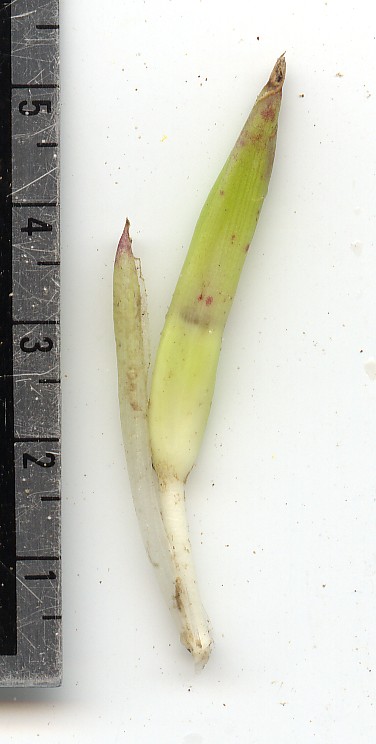
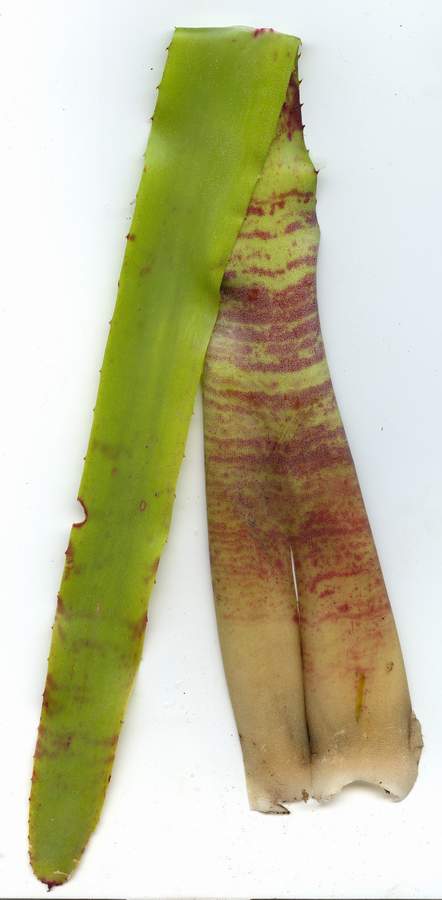

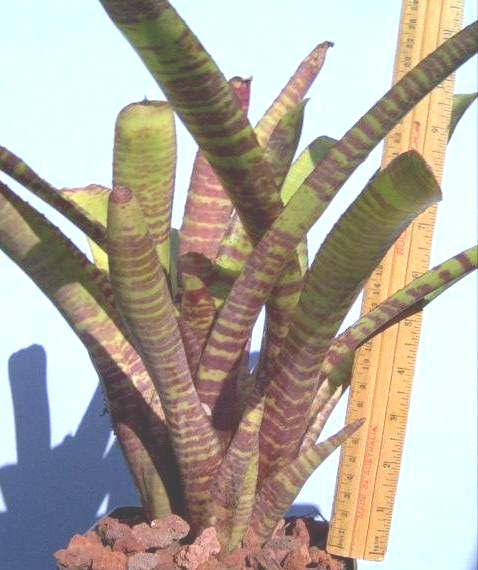
Neoregelia zonata L. B. Smith, Arq. Bot. S. Paulo II. 2: 120, pl. 51. 1950.
Desc from S&D
Plant propagating by stolons.
Leaves few, rosulate, 25-34 cm long, pale appressed-lepidote and strongly purple-banded on both sides;
sheaths elliptic, 10-12 cm long;
blades ligulate, not narrowed at base, rounded and apiculate, 2-3 cm wide, laxly serrate with dark spines 2 mm long.
Scape short.
Inflorescence simple, ca. 15-flowered, pale-flocculose, soon glabrous.
Floral bracts slightly exceeding the ovary, thin, serrulate, the outer ovate, the floral oblong; pedicels slender, to 13 mm long.
Sepals elliptic, asymmetric, acute but not mucronulate, 26 mm long, connate for 3 mm; petals naked, 37 mm long, white except for the blue apex;
stamens included;
ovary ellipsoid, 12 mm long, the epigynous tube funnelform, 4 mm long; placentae subapical; ovules obtuse.
Type. Foster 197 (holotype OH, isotypes R, US), litoral, Vit6ria, Espirito Santo, Brazil, 11 Jul 1939.
Distribution. Known from the type collection only. Cultivation: Jul 1961, R. G. Wilson 34 (US).
QUESTIONS QUESTIONS QUESTIONS by Derek Butcher South Australia.
In Bromeletter 31(4):10-11. 1993
What I like about Conferences is that you get a chance to look at plants and labels. In your own backyard or even Society you get a biased view as to what a plant looks like or should look like. I am a plant person rather than a people person so I will let others write on that aspect of the Brisbane Conference. From my point of view if plants don't like you they quietly die whereas if people don't like you they get grumpy and illogical.
Wasn't Elton Leme a great asset? I was lucky to be fossicking around Olive Trevor's place when he first arrived. His grasp of the Brazilian Bromeliaceae was immediately evident as he recognised many of Olive's species vrieseas without looking at the labels. Once or twice Olive named a plant only to be corrected and reasons given as to why Elton thought a particular name applied. This was interesting stuff and had Olive scurrying for blank labels.
Now we all know what Neoregelia zonata looks like, don't we? Elton sent seed of a plant of this name some three years ago and I had sent portions to various interested growers throughout Australia. BUT my portion had produced plants looking like N. carcharodon and I had taken one plant to the Conference specifically to present to Elton. So I pulled out my plant from its newspaper wrapping and asked Elton its name.
Neoregelia zonata was the reply and there I was like a stunned mullet. “What’s the difference between this and N. carcharodon?" I finally managed to squeeze out. The succinct answer "very similar". There were no flowers so the answer was given on the shape and colour of the leaf and plant. I asked about N. pascoaliana but Elton was not familiar with the name or my pronounciation. Now you know why this article is called "Questions". Prior to my questioning I did have preconceived ideas!
I had been to Peter Franklin's place at Raymond Terrace, NSW and seen a seedling tray of N. pascoaliana {ex B.S.A. seed bank) and a seedling tray of Leme's N. zonata. At that stage of growth they seemed to be very similar - even Peter agreed with me!
I had been to Peter Tristram's place and seen his variegated N. carcharodon which had come from Chester Skotak in Costa Rica. You don't find many Neoregelias in Costa Rica but apparently importations had been made from Brazil and a hybridising programme commenced. If the detail given in the B.S.I. Listing of cultivar and grex names is correct then Peter's plant is not a variegated species but a variegated hybrid with N. carcharodon {or N. pascoaliana) as FATHER. MOTHER isn't mentioned.
I had been to Olive Trevor's place and seen Peter's plant again and with my usual polite questioning was also shown an import from the U.S. named N. carcharodon var. rubra. This is undoubtedly the plant that Harry Luther maintains is N. pascoaliana.
None of these looks like the monster I have with thick spines which I got many years ago from Olwen Ferris under the name of N. carcharodon. Few seen to want to grow it although its leaves are strongly marked and it is an impressive plant. Does the seed in the B.S.A. seed bank named N. pascoaliana come from our "original " N. carcharodon? Was Olwen too quick in changing the name a-la-Luther? I believe so if we are to agree with Elton's comment that N. carcharodon and N. zonata are similar and with Peter Franklin's seed raising effort.
These are reasons to suggest that all 3 species are here in Australia but we need floral parts and a leaf to be sent to Harry Luther to get a third opinion on this threesome.
At question time at the Conference I showed Neoregelia zonata ex Leme to the assembly but none volunteered a name although I did hear a murmur of Aechmea ! I sensed a feeling of shock when I announced the name and when I wanted to give away the specimen there were many hands raised. The winner was Olive Trevor but I did this without fear or favour. After all the plant had been wrapped up in newspaper for two weeks. Remember there are lots of these N. zonata with Peter Franklin, who is a stalwart with the Hunter Valley bromeliad group.
For those who may ask "What has happened to OUR N. zonata?" I can only say it's another story. BUT I did get a TRUE N. 'Marnier Lapostolle' from Len Butt a few years back and his comment then was that it looked like N. zonata. Could it be that OUR N. zonata is the hybrid N. 'Marnier Lapostolle' whose parents are N. zonata and N. ampullacea? That I can't answer, but its worth thinking about! ! ! !
ANSWERS ANSWERS ANSWERS
by Harry E. Luther, Director, B.I.C. U.S.A. in Bromeletter 31(5):12-13.1993
One of the major benefits, in my opinion, of working mainly with Andean Bromeliaceae is the lack of true Neoregelias. They are the bane of my existence.
Let's discuss a trio of these that recently were mentioned by Derek Butcher, in the Bromletter. I must make clear at this point that I really do not know what is in cultivation in Australia and will probably remain ignorant until someone kindly sends me adequate material of the plants in question. I do have a good idea what the species in question are and what they should look like and how they differ from one another. The following refers to the "true" species and may have little to do with what is being grown in Australia.
Neoregelia carcharodon (Baker) L.B.Smith is a large plant. Based on the original description and supplemental material, the leaves are 40-70cm long & 6-9cm broad. The curving marginal spines are 4-8mm long. The leaves are inconspicuously lepidote, they are green or tinged red. The inflorescence is 8-10cm in diameter and the sepals are 3-4cm long. This plant in the USA is called N. carcharodon 'Rubra'. Several collectors have told me that they were sure it was a Canistrum until it flowered for them. Flowering is evidently uncommon. Chester Skotak has made several hybrids & backcrossed to this plant. Many are variegated. Most are beautiful.
Neoregelia pascoaliana L.B.Smith is also a large plant. Based on the original description, the leaves are 40-50cm long (perhaps longer in cultivation) and 7-9cm broad. The leaves are densely appressed lepidote, they appear grey green and are spotted and mottled with purple. The antrorse marginal spines are 2-4mm long. The inflorescence is about 8cm in diameter and the sepals are 2-3cm long. This plant has long been misidentified in the USA as N. carcharodon. It has not been very popular with hybridisers.
Neoregelia zonata L.B. Smith is a much smaller plant. Based on the original description and type specimen (but not the original illustration, more on that later) the leaves are 25-35cm long and 2-3cm broad. The straight to antrorse marginal spines are 1-2mm long. The leaves are, according to M. B . Foster, "light green with reddish blotched banded both sides of leaf". The label description may not be articulate but it does the job. The inflorescence on the type specimen is split and smashed, it is about 6cm in diameter but I suspect that normally it would be 3-4cm broad at most. The sepals are 25-26mm long. I do not know if N. zonata is still in cultivation. I remember seeing it as a mere lad. What passes today are smaller and may be hybrids with N. ampullacea or something similarly smaller. I also remember seeing a hybrid of N. zonata and N. 'Fireball' (or so it was labelled). I shall be checking into this species' status in horticulture; perhaps we've lost another one.
The illustration is of the type of Neoregelia zonata that was published in the Brazilian Journal Arquivos de Botanica do Estado de Sao Paulo in 1950. A nice drawing but the included scales are not to be trusted. Note that according to the scale the leaf blades would be 6-9cm broad! They are not, as mentioned above, they are 3cm or less in width, perhaps this plate is the source of confusion with N. carcharodon and N. pascoaliana.
NOTE Bill Morris advises that the Australian N. zonata breeds true from seed.